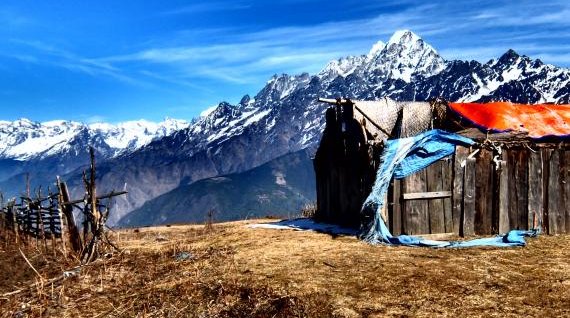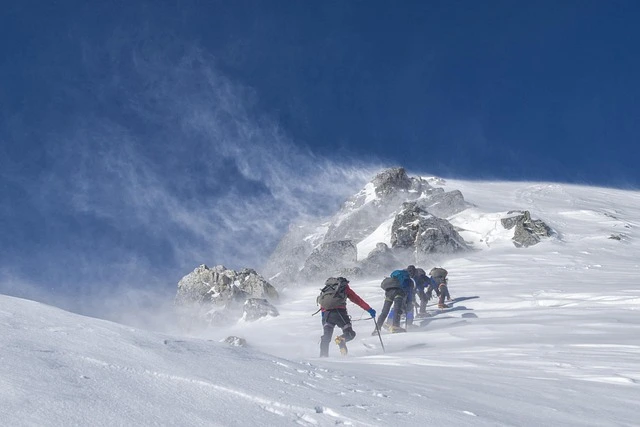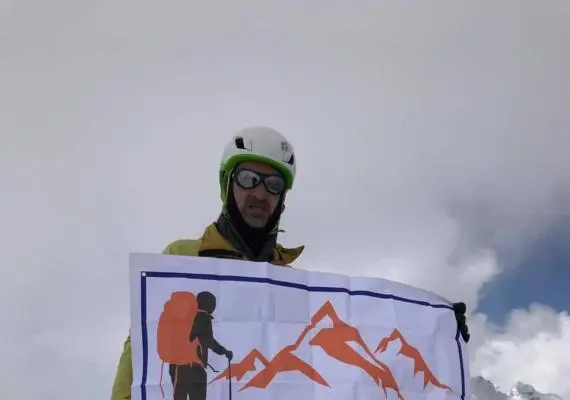The Tamang Heritage Trail Trek offers an extraordinary cultural immersion into one of Nepal's most authentic ethnic communities, where traditional lifestyles remain unchanged by modern tourism. This moderate trek through the Langtang region combines stunning Himalayan panoramas with genuine homestay experiences, allowing travelers to share meals, stories, and daily life with Tamang families who have inhabited these mountain villages for centuries. From the healing waters of Tatopani hot springs to the ancient monasteries perched on hillsides, every step reveals the rich tapestry of Tamang culture against the backdrop of snow-capped peaks.
Unlike the crowded trails of Everest and Annapurna, the Tamang Heritage Trail provides an intimate window into rural Nepalese life while delivering spectacular views of Langtang Liri, Ganesh Himal, and even glimpses of Tibet. The trek connects traditional villages through well-maintained paths, offering comfortable homestays where families welcome guests with warm hospitality and home-cooked meals. This carefully designed route ensures trekkers experience the perfect balance of cultural authenticity and natural beauty, making it ideal for those seeking meaningful connections beyond typical tourist experiences.
Trip Highlights
- Authentic homestay experiences in traditional Tamang villages including Gatlang, Goljung, and Briddim
- Natural hot springs at Tatopani for therapeutic relaxation after trekking
- Panoramic mountain views of Langtang Liri (7,227m), Ganesh Himal, and Tibetan peaks
- Ancient Buddhist monasteries and sacred sites with colorful prayer flags
- Traditional Tamang cultural performances including folk songs and dances
- Local cheese factory visits in Gatlang showcasing yak cheese production
- Scenic viewpoints at Nagthali offering 360-degree Himalayan vistas
- Interaction with ex-Gurkha soldiers sharing fascinating military stories
- Traditional handicraft demonstrations including weaving and wood carving
- Wildlife spotting opportunities including red pandas, Himalayan black bears, and langur monkeys
Tamang Heritage Trail Trek 12-Day Itinerary
- Day 1: Kathmandu to Syabrubesi (1,503m) - 7-hour scenic drive
- Day 2: Trek to Gatlang (2,238m) - 5 hours through terraced fields
- Day 3: Gatlang to Tatopani (2,607m) - 6 hours via Chilime
- Day 4: Tatopani to Thuman (2,338m) - 5 hours through forests
- Day 5: Thuman to Briddim (2,229m) - 5 hours cultural trail
- Day 6: Rest day in Briddim - monastery visit and cultural activities
- Day 7: Briddim to Syabrubesi - 3 hours descent
- Day 8: Syabrubesi to Goljung (2,130m) - 5 hours hillside trek
- Day 9: Goljung excursion day - local activities and viewpoints
- Day 10: Goljung to Syabrubesi - 4 hours return trek
- Day 11: Drive to Kathmandu - 7 hours
- Day 12: Departure from Kathmandu
Understanding the Tamang Heritage Trail
The Origins of Community-Based Tourism
The Tamang Heritage Trail emerged as a community-based tourism initiative following the 2015 earthquake, designed to support local reconstruction while preserving cultural traditions. This carefully planned route connects six main Tamang villages in the Rasuwa district, each offering unique insights into this ancient Tibetan-origin community. The trail maintains moderate difficulty levels throughout, making it accessible to most fitness levels while providing authentic cultural encounters rarely found on commercial trekking routes.
The Tamang People and Their Culture
The Tamang people, one of Nepal's major indigenous groups, have maintained their distinct culture, language, and Buddhist practices for generations. Their villages showcase traditional stone houses with intricately carved wooden windows, prayer wheels at every corner, and colorful prayer flags fluttering against mountain backdrops. The homestay system ensures tourism revenue directly benefits local families, who take pride in sharing their customs, cuisine, and centuries-old traditions with respectful visitors.
Best Season for Tamang Heritage Trail Trek
Spring Season (March to May)
Spring brings ideal trekking conditions to the Langtang region. The season offers:
- Rhododendron blooms painting hillsides in vibrant colors
- Clear mountain views with minimal cloud cover
- Moderate temperatures perfect for comfortable hiking
- Agricultural activities providing insights into farming life
- Wildlife activity as animals emerge from winter hibernation
Autumn Season (September to November)
Autumn delivers optimal trekking conditions with distinct advantages:
- Crystal-clear visibility for photography enthusiasts
- Stable weather patterns with minimal precipitation
- Festival season offering cultural immersion opportunities
- Harvest time showcasing traditional agricultural practices
- Pleasant temperatures during both day and night
Winter and Monsoon Considerations
Winter trekking (December to February) remains feasible due to lower elevations, offering pristine snow-capped views and minimal tourist presence. Summer monsoon (June to August) brings lush landscapes but requires proper rain gear and flexibility with mountain views.
Detailed Trail Description
Syabrubesi to Gatlang: Gateway to Tamang Culture
The Journey Begins
The trek commences in Syabrubesi, a bustling town serving as the gateway to both Langtang Valley and Tamang Heritage routes. The initial trail section features:
- Bhote Koshi River crossing via sturdy suspension bridge
- Gradual ascent through terraced fields and scattered settlements
- Expanding views of Ganesh Himal range
- Traditional architecture becoming increasingly prominent
Gatlang Village Experience
Gatlang village sits majestically on a hillside, offering the first authentic homestay experience. Key attractions include:
- Traditional stone houses with intricate wooden carvings
- Ancient monastery providing panoramic mountain views
- Cultural performances featuring traditional songs and dances
- Local cheese factory demonstrating yak cheese production
- Community interactions with warm, welcoming villagers
Tatopani Hot Springs: Natural Healing Waters
The Therapeutic Experience
The trail from Gatlang descends through forests before reaching Tatopani's renowned hot springs. These natural thermal pools offer:
- Mineral-rich waters with healing properties
- Temperature variations suitable for different preferences
- Basic facilities maintained by the local community
- Scenic setting beside the Chilime Khola river
- Cultural significance in traditional healing practices
Village Life Around Tatopani
The surrounding village provides additional cultural experiences:
- Traditional paper-making demonstrations
- Local handicraft production and sales
- Interaction opportunities with resident families
- Agricultural insights into mountain farming
- Evening gatherings with storytelling sessions
Thuman and Briddim: Heart of Tamang Heritage
Thuman Village Highlights
Thuman represents one of the trail's cultural pinnacles:
- Strong Tibetan influence in architecture and customs
- Ancient monastery housing religious artifacts
- Traditional healing practices still actively maintained
- Historic trade route stories from elderly residents
- Shamanic traditions integrated into daily life
Briddim's Exceptional Offerings
Briddim provides perhaps the most comprehensive cultural experience:
- Community museum displaying traditional artifacts
- Weaving demonstrations by skilled local women
- Sunrise viewpoint over the Langtang range
- Homestay excellence with engaged host families
- Cultural preservation efforts visible throughout
Goljung: Off the Beaten Path
Authentic Village Life
This newer addition to the trail offers:
- Minimal tourist impact on traditional lifestyles
- School visits providing educational insights
- Day hike opportunities to surrounding viewpoints
- Forest conservation projects and initiatives
- Traditional knowledge sharing about medicinal plants
Cultural Experiences Along the Trail
Traditional Tamang Lifestyle
Daily Life and Activities
Tamang villages maintain agricultural lifestyles featuring:
- Subsistence farming of barley, millet, and potatoes
- Animal husbandry including yaks, goats, and chickens
- Traditional crafts passed through generations
- Cooperative labor during planting and harvest seasons
- Gender roles in household and community management
Architectural Heritage
Traditional Tamang houses reflect practical mountain design:
- Stone construction for durability and insulation
- Wooden details showcasing artistic skills
- Ground floor livestock accommodation in winter
- Upper floor living spaces for families
- Central kitchen serving as the home's social hub
Religious Practices and Festivals
Buddhist Influence
Buddhism profoundly shapes Tamang life through:
- Daily prayer rituals at dawn and dusk
- Monastery visits for special occasions
- Prayer wheel circuits around villages
- Sacred site maintenance by community members
- Meditation practices integrated into daily routines
Festival Celebrations
Major festivals transform villages into vibrant celebrations:
- Losar (Tibetan New Year) with elaborate ceremonies
- Buddha Jayanti honoring Buddhism's founder
- Harvest festivals thanking deities for abundance
- Local deity worship unique to each village
- Community feasts strengthening social bonds
Homestay Experience: Living with Local Families
Accommodation Standards
Room Facilities
Homestay accommodations provide:
- Clean bedding with traditional blankets
- Basic furniture including beds and storage
- Shared bathrooms with local-style toilets
- Common areas for socializing with families
- Mountain views from most locations
Meal Experiences
Traditional hospitality includes:
- Dal bhat served with unlimited refills
- Local specialties like syakpa and tingmo
- Seasonal vegetables from family gardens
- Traditional beverages including butter tea
- Communal dining around kitchen fires
Cultural Exchange Opportunities
Evening Interactions
Homestays facilitate meaningful exchanges through:
- Storytelling sessions about village history
- Folk song performances by family members
- Traditional game demonstrations
- Language lessons in basic Tamang phrases
- Cooking participation in meal preparation
Communication Strategies
Overcoming language barriers involves:
- Basic Nepali phrases for essential communication
- Gesture communication for complex ideas
- Translation apps for important conversations
- Guide assistance when available
- Patience and humor creating connections
Practical Information for Trekkers
Permits and Regulations
Required Documentation
The Tamang Heritage Trail requires:
- Langtang National Park Permit - NPR 3,000 (USD 30)
- TIMS Card - NPR 1,000-2,000 depending on trek type
- Passport copies for permit applications
- Passport photos (4 copies recommended)
- Emergency contact information
Restricted Area Considerations
Border proximity requires awareness of:
- Checkpoint locations along the trail
- Restricted zones near Tibet border
- Photography limitations at certain locations
- Guide requirements for specific areas
- Permit verification at multiple points
Physical Demands and Preparation
Fitness Requirements
The trek demands:
- Moderate fitness level for daily hiking
- Stamina for 3-7 hour walking days
- Balance for uneven terrain navigation
- Flexibility for weather variations
- Mental preparation for basic facilities
Training Recommendations
Prepare effectively through:
- Regular hiking with increasing distances
- Stair climbing for leg strength
- Backpack training with weight
- Cardiovascular exercises for endurance
- Flexibility routines for injury prevention
Packing Essentials
Clothing Requirements
Essential clothing includes:
- Layering system for temperature variations
- Waterproof jacket and pants
- Insulation layers for cold evenings
- Quick-dry fabrics for easy washing
- Modest clothing respecting local culture
Equipment Necessities
Critical gear comprises:
- Sturdy hiking boots properly broken in
- Sleeping bag rated for cold temperatures
- Trekking poles for stability
- Headlamp with spare batteries
- Water purification tablets or filter
Tamang Heritage Trail Trek Cost Analysis
Cost Breakdown for Foreign Travelers
Foreign nationals undertaking the Tamang Heritage Trail can expect comprehensive costs ranging from USD 700 to 1,500 depending on service levels. Budget-conscious travelers spending approximately USD 700-900 will receive basic guide services, standard homestay accommodations, all meals during the trek, necessary permits, and round-trip transportation from Kathmandu. Mid-range packages costing USD 1,000-1,200 include experienced English-speaking guides, porter services, slightly upgraded accommodations where available, and additional cultural activities. Premium services ranging from USD 1,300-1,500 feature private transportation, premium guide services, flexibility in itinerary modifications, and comprehensive insurance coverage for all staff members.
Special Pricing for Indian Travelers
Indian citizens enjoy significantly reduced costs due to special bilateral agreements between Nepal and India. The Langtang National Park permit costs only NPR 100 (compared to NPR 3,000 for other foreign nationals), while SAARC citizens receive discounted TIMS cards at NPR 200-300. Total trek costs for Indian nationals typically range from USD 400-800, representing savings of 30-40% compared to other foreign travelers. Many operators offer special Indian citizen packages including Hindi-speaking guides, familiar meal options, and payment flexibility in Indian rupees. Group bookings from India often receive additional discounts, making the trek particularly attractive for Indian adventure enthusiasts.
Hidden Costs and Budget Planning
Travelers frequently underestimate additional expenses beyond package prices. Hot spring entrance fees cost NPR 100-200 per person, while charging electronic devices incurs NPR 200-500 daily at higher elevations. Beverages including tea, coffee, and soft drinks add USD 3-5 daily to expenses. WiFi access, where available, costs NPR 500-1000 per day. Recommended tipping totals approximately USD 50-80 for the entire trek, distributed among guides, porters, and homestay families. Emergency fund allocation of USD 200-300 proves prudent for unexpected situations including weather delays, medical needs, or evacuation requirements. Souvenir purchases from village handicraft centers typically range from USD 20-100 depending on items selected.
Book Your Authentic Tamang Heritage Adventure
The Tamang Heritage Trail offers an unparalleled opportunity to experience Nepal's rich cultural diversity while enjoying spectacular Himalayan scenery. This carefully crafted trek balances authentic cultural immersion with comfortable homestay accommodations, making it perfect for travelers seeking meaningful connections beyond typical tourist experiences. From sharing traditional meals with Tamang families to soaking in natural hot springs with mountain views, every moment creates lasting memories.
Ready to embark on this transformative cultural journey? Book your guided Tamang Heritage Trail trek today and discover the warmth of Tamang hospitality, the beauty of traditional villages, and the majesty of the Himalayas. Our experienced local guides ensure you don't just visit these communities – you become welcomed guests sharing in their daily lives, traditions, and stories. Contact us now to reserve your authentic homestay trek and support sustainable community tourism while creating memories that last a lifetime.





